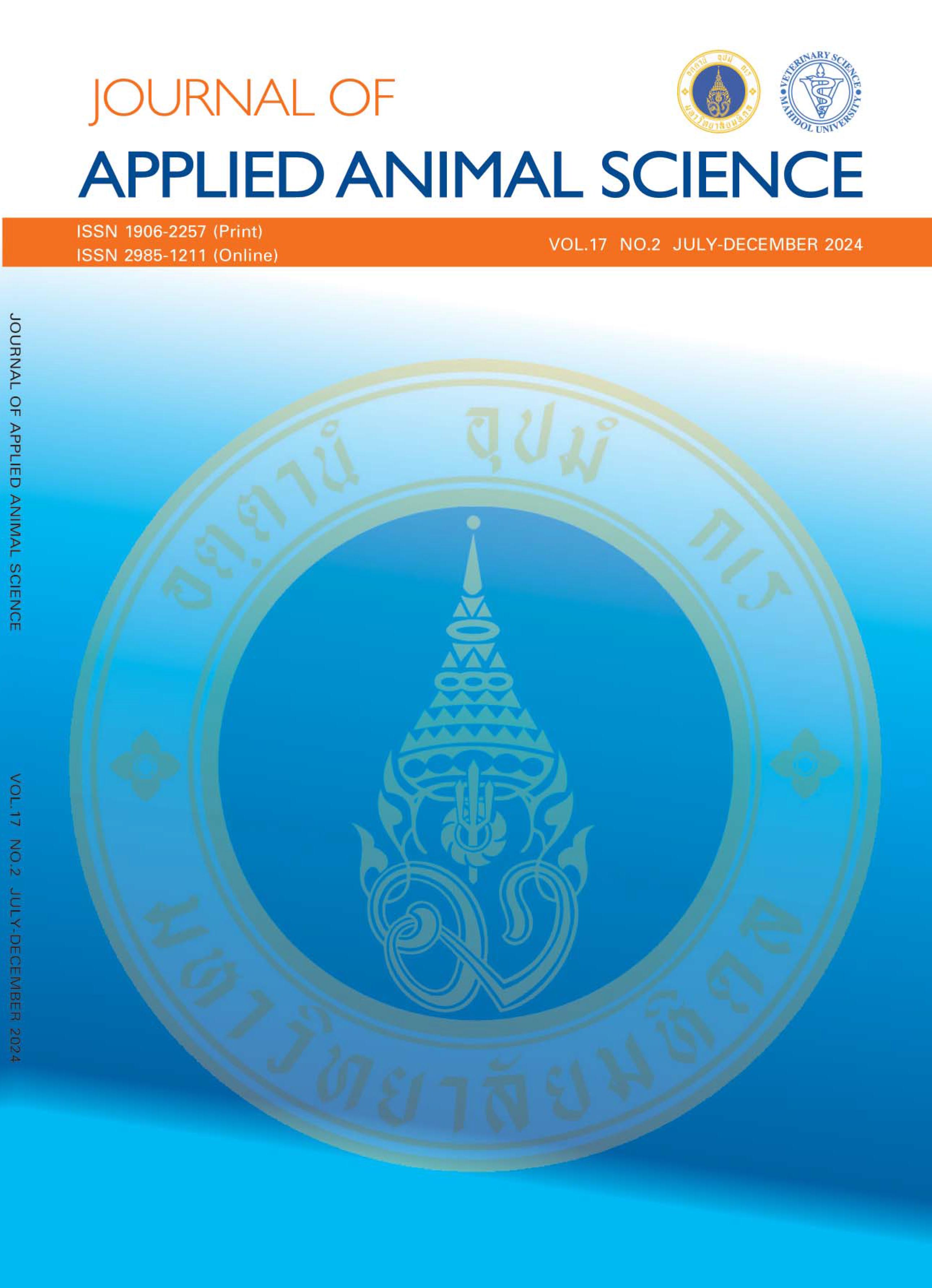รายงานสัตว์ป่วย: การผ่าตัดแก้ไขและการระบายเยื่อหุ้มหัวใจโรคไส้เลื่อนกะบังลมเยื่อบุช่องท้องและเยื่อหุ้มหัวใจแต่กำเนิดในแมวสกอตติช โฟลด์
คำสำคัญ:
แมว , สายสวนระบายเยื่อหุ้มหัวใจ, โรคไส้เลื่อนกระบังลมเยื่อบุช่องท้องและเยื่อหุ้มหัวใจ, การรักษาโดยการศัลยกรรมบทคัดย่อ
โรคไส้เลื่อนกะบังลมเยื่อบุช่องท้องและเยื่อหุ้มหัวใจ (Peritoneopericardial diaphragmatic hernia: PPDH) เป็นความผิดปกติตั้งแต่กำเนิดที่ส่งผลกระทบต่อกะบังลมและเยื่อหุ้มหัวใจ พบได้บ่อยในแมว รายงานนี้มีวัตถุประสงค์เพื่อนำเสนอกรณีศึกษาของแมวสายพันธุ์สกอตติช โฟลด์ อายุ 4 เดือน เพศผู้ ยังไม่ทำหมันซึ่งได้รับการวินิจฉัยว่าเป็นโรค PPDH โดยเน้นที่เทคนิคการผ่าตัดที่มีการใส่สายสวนระบายเยื่อหุ้มหัวใจและผลลัพธ์ระยะยาว โดยสัตว์ป่วยมาด้วยอาการอาเจียนเฉียบพลัน โดยจากการตรวจร่างกายพบว่าสัตว์ป่วยมีการหายใจโดยใช้ช่องท้องและรู้สึกไม่สบายเล็กน้อยเมื่อมีการคลำบริเวณช่องท้อง และไม่พบประวัติของอาการหายใจลำบากและลักษณะเขียวคล้ำของเยื่อเมือกมาก่อน โดยจากการถ่ายภาพรังสีช่องอกช่วยยืนยันการพบภาวะไส้เลื่อนกะบังลมและจากภาพอัลตร้าซาวด์ช่องท้องพบการเคลื่อนของตับและถุงน้ำดีเข้าสู่ช่องเยื่อหุ้มหัวใจ พร้อมกับพบการหนาตัวของผนังลำไส้ จากผลการตรวจข้างต้นสัตว์ป่วยจึงถูกวินิจฉัยว่าเป็นโรค PPDH แต่กำเนิด และได้มีการผ่าตัดแก้ไขโรค PPDH โดยพบว่าอวัยวะที่เข้าไปอยู่ในเยื่อหุ้มหัวใจคือตับและถุงน้ำดี จากนั้นจึงได้ทำการเย็บปิด PPDH โดยใช้ไนลอนเบอร์ 3-0 โดยใช้เทคนิคการเย็บแบบต่อเนื่องจากนั้นมีการดูดอากาศออกจากเยื่อหุ้มหัวใจผ่านทางสายสวนระบายเพื่อสร้างแรงดันลบ หลังการผ่าตัด 1 ปี พบว่าแมวมีการหายใจเป็นปกติและมีสุขภาพโดยรวมที่ดี
เอกสารอ้างอิง
Banz AC, Gottfried SD. Peritoneopericardial diaphragmatic hernia: a retrospective study of 31 cats and eight dogs. J Am Anim Hosp Assoc. 2010;46(6):398-404.
Burns CG, Bergh MS, McLoughlin MA. Surgical and nonsurgical treatment of peritoneopericardial diaphragmatic hernia in dogs and cats: 58 cases (1999-2008). J Am Vet Med Assoc. 2013;242(5):643-50.
Campanile D, Cafaro M, Paci S, Panarese M, Sparapano G, Masi M, De Simone A. Evidence of pneumopericardium after elective ovariectomy in a peritoneopericardial diaphragmatic hernia-affected dog: A case report. Animals (Basel). 2024;14(4).
Fossum TW. Surgery of the lower respiratory system: pleural cavity and diaphragm. In: Fossum TW, editor. Small Animal Surgery. 5th ed. St. Louis: Mosby; 2018. p. 916-57.
Häggström J, Andersson ÅO, Falk T, Nilsfors L, Olsson U, Kresken JG, et al. Effect of body weight on echocardiographic measurements in 19,866 pure-bred cats with or without heart disease. J Vet Intern Med. 2016;30(5):1601-11.
Heier E, Wurtinger G, Hassdenteufel E, Schneider M. Therapy of pyothorax in cats via small-bore thoracostomy tube in terms of efficacy, complications and outcomes. Animals (Basel). 2022;12(1).
Hunt GB, Johnson KA. Diaphragmatic Hernias. In: Tobias KM, Johnston SA, editors. Veterinary surgery small animal. 1st ed. St Louis: Elsevier Saunders; 2012. p. 1380-91.
Imazio M, Hoit BD. Post-cardiac injury syndromes. An emerging cause of pericardial diseases. Int J Cardiol. 2013;168(2):648-52.
Lee JH, Kim SW. Small bowel strangulation due to peritoneopericardial diaphragmatic hernia. J Cardiothorac Surg. 2014;9:65.
Legallet C, Thieman Mankin K, Selmic LE. Prognostic indicators for perioperative survival after diaphragmatic herniorrhaphy in cats and dogs: 96 cases (2001-2013). BMC Vet Res. 2017;13(1):16.
Less RD, Bright JM, Orton EC. Intrapericardial cyst causing cardiac tamponade in a cat. J Am Anim Hosp Assoc. 2000;36(2):115-9.
Linton M, Tong L, Simon A, Buffa E, McGregor R, Labruyére J, Foster D. Hepatic fibrosarcoma incarcerated in a peritoneopericardial diaphragmatic hernia in a cat. JFMS Open Rep. 2016;2(1):2055116916638681.
Lohinger C, Gumpenberger M, Kolm US, Degasperi B. Pneumopericardium with concomitant pericardial effusion following peritoneopericardial diaphragmatic hernia repair in a dog. Vet Rec Case Rep. 2022;10(2):e278.
Margolis C, Zakošek Pipan M, Demchur J, Or M, Henthorn P, Casal ML. Congenital peritoneopericardial diaphragmatic hernia in a family of Persian cats. JFMS Open Rep. 2018;4(2):2055116918804305.
Morgan KRS, Singh A, Giuffrida MA, Balsa IM, Hayes G, Chu ML, et al. Outcome after surgical and conservative treatments of canine peritoneopericardial diaphragmatic hernia: A multi-institutional study of 128 dogs. Vet Surg. 2020;49(1):138-45.
Nikiphorou X, Chioti R, Patsikas M, Papazoglou L. Peritoneopericardial diaphragmatic hernia in the dog and cat. J Hellenic Vet Med Soc. 2016;67:189-94.
Papazoglou LG, Patsikas MN, Deligianni A, Wisner ER, Kazakos G. Pneumopericardium associated with peritoneopericardial diaphragmatic hernia repair in a dog. Vet Med. 2015;110(4):94-8.
Reimer SB, Kyles AE, Filipowicz DE, Gregory CR. Long-term outcome of cats treated conservatively or surgically for peritoneopericardial diaphragmatic hernia: 66 cases (1987-2002). J Am Vet Med Assoc. 2004;224(5):728-32.
Sicoe B, Dascălu R, Schüszler L, Bumb D, Zaha C, Igna C. Surgical treatment of a traumatic diaphragmatic hernia in a cat using Stratafix™ barbed suture: case report. Sci Works Ser C Vet Med. 2019;(1):89-93.
ดาวน์โหลด
เผยแพร่แล้ว
รูปแบบการอ้างอิง
ฉบับ
ประเภทบทความ
สัญญาอนุญาต
ลิขสิทธิ์ (c) 2024 คณะสัตวแพทยศาสตร์ มหาวิทยาลัยมหิดล

อนุญาตภายใต้เงื่อนไข Creative Commons Attribution-NonCommercial-NoDerivatives 4.0 International License.
เนื้อหาและข้อมูลในบทความที่ลงตีพิมพ์ในวารสาร Journal of Applied Animal Science ถือเป็นข้อคิดเห็นและความรับผิดชอบของผู้เขียนบทความโดยตรงซึ่งกองบรรณาธิการวารสาร ไม่จำเป็นต้องเห็นด้วย หรือร่วมรับผิดชอบใด ๆ
บทความ ข้อมูล เนื้อหา รูปภาพ ฯลฯ ที่ได้รับการตีพิมพ์ในวารสาร Journal of Applied Animal Science ถือเป็นลิขสิทธิ์ของวารสาร Journal of Applied Animal Science หากบุคคลหรือหน่วยงานใดต้องการนำทั้งหมดหรือส่วนหนึ่งส่วนใดไปเผยแพร่ต่อหรือเพื่อกระทำการใด ๆ จะต้องได้รับอนุญาตเป็นลายลักอักษรจากวารสาร Journal of Applied Animal Science ก่อนเท่านั้น



